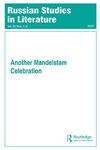Russian Futurist and Avant-Garde Works and Aesthetics
4区 文学
Q4 Arts and Humanities
引用次数: 0
Abstract
All three substantial articles in this issue of Russian Studies in Literature consider the connection of art (verbal or pictorial) with politics, and with leftist politics in particular. All three are concerned with the interactions of literature and visual arts, which typified the activities of the Russian Futurists as well as the scholars who studied them and subsequent generations of avant-garde artists and writers who learned from or continued their strategies. The Futurists (especially Khlebnikov and Mayakovsky, each in his own way) have exerted an enduring attraction for writers and scholars abroad, as well as for generations of creative artists working in Russia or in Russian. Evgenii Demenok’s “Graphic Symbols: Khlebnikov, Burliuk, and Kruchenykh” focuses primarily on the Futurist poet Velimit Khlebnikov (1885-1922) as a visual artist. Biographical and bibliographic data are drawn from various memoirists, especially David Burliuk but with copious citations from Roman Jakobson, Aleksei Kruchenykh, Benedikt Livshits, and Vladimir Mayakovsky. Anyone who wants to know more about Khlebnikov’s life and personality, and especially anyone interested in the interactions of visual art and poetry in Futurist practice, will find a wealth of information here. Demenok draws especially on material from David and Mariia Burliuk’s journal Color and Rhyme, published in both English and Russian in New York City through the 1970s. Anatolii Rykov’s article is entitled “Between a Conservative Revolution and Bolshevism: Nikolai Punin’s Total Aesthetic Mobilization.” Art historian Nikolai Punin (1888-1953) may be best known to readers of this journal Russian Studies in Literature, vol. 53, no. 2, 2017, pp. 103–104. © 2017 Taylor & Francis Group ISSN: 1061-1975 (print)/ISSN 1944-7167 (online) DOI: https://doi.org/10.1080/10611975.2017.1424434俄罗斯未来主义和先锋派作品与美学
本期《俄罗斯文学研究》的三篇实质性文章都考虑了艺术(语言或图像)与政治的联系,尤其是与左翼政治的联系。这三者都关注文学和视觉艺术的互动,这代表了俄罗斯未来主义者、研究他们的学者以及后来几代先锋艺术家和作家的活动,他们学习或延续了他们的策略。未来主义者(尤其是赫列布尼科夫和马亚科夫斯基,他们各自以自己的方式)对国外的作家和学者,以及在俄罗斯或俄语工作的几代创造性艺术家产生了持久的吸引力。叶夫根尼·德米诺克的《图形符号:赫列布尼科夫、伯留克和克鲁切尼克》主要关注未来主义诗人赫列布尼夫(1885-1922)作为视觉艺术家的形象。传记和书目数据来自各种回忆录作者,尤其是David Burliuk,但也大量引用了Roman Jakobson、Aleksei Kruchenykh、Benedikt Livshits和Vladimir Mayakovsky。任何想了解赫列布尼科夫生活和个性的人,尤其是对视觉艺术和诗歌在未来主义实践中的互动感兴趣的人,都会在这里找到丰富的信息。Demenok特别借鉴了David和Mariia Burliuk的《颜色与韵律》杂志中的材料,该杂志于20世纪70年代在纽约市以英语和俄语出版。Anatolii Rykov的文章题为“在保守革命和布尔什维克主义之间:尼古拉·普宁的全面美学动员”。艺术史学家尼古拉·普宁(1888-1953)最为读者所知的可能是《俄罗斯文学研究》杂志,第53卷,2017年第2期,第103–104页。©2017 Taylor&Francis Group ISSN:1061-1975(印刷版)/ISN 1944-7167(在线版)DOI:https://doi.org/10.1080/10611975.2017.1424434
本文章由计算机程序翻译,如有差异,请以英文原文为准。
求助全文
约1分钟内获得全文
求助全文
来源期刊

RUSSIAN STUDIES IN LITERATURE
LITERATURE, SLAVIC-
自引率
0.00%
发文量
0
期刊介绍:
Russian Studies in Literature publishes high-quality, annotated translations of Russian literary criticism and scholarship on contemporary works and popular cultural topics as well as the classics. Selections are drawn from the leading literary periodicals including Literaturnaia gazeta (Literary Gazette), Novoe literaturnoe obozrenie (New Literary Review), Oktiabr (October), Voprosy literatury (Problems of Literature), and Znamia (Banner). An editorial introduction to every issue provides context and insight that will be helpful for English-language readers.
 求助内容:
求助内容: 应助结果提醒方式:
应助结果提醒方式:


